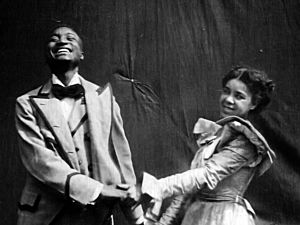Gertie Brown facts for kids
Quick facts for kids
Gertie Brown
|
|
|---|---|

Saint Suttle (left) and Gertie Brown (right) in a still from the 1898 silent film "Something Good -- Negro Kiss."
|
|
| Born |
Gilberta Gertrude Chevalier
August 23, 1878 Washington, Guernsey County, Ohio, USA
|
| Died | February 24, 1934 (aged 55) New York City, U.S.
|
| Other names | Gertie Brown, Gertie Brown Moore, Gertie Moore, Gertrude Brown, Gertrude Brown Moore, Gertrude Moore |
| Occupation | Actress |
| Spouse(s) | Tim Moore (1915–1934) (her death) |
Gertie Brown Moore was an amazing actress and performer. She was born Gilberta Gertrude Chevalier on August 23, 1878. She passed away on February 24, 1934, at age 55. Gertie was one of the first African-American film actresses. She was also a popular vaudeville performer. Vaudeville was a type of entertainment with many different acts. Gertie is best known for her role in the 1898 silent film Something Good – Negro Kiss. This film became very popular online in 2018.
Contents
Gertie Brown's Early Life and Career
Gertie Brown was born in 1878. She started performing on stage when she was only nine years old! In the 1890s, she performed in vaudeville shows. She also performed in minstrel shows. These shows were popular in the Chicago area and across the country.
Gertie performed with a famous composer named Saint Suttle. Together with John and Maud Brewster, they formed a group. They called themselves "The Rag-Time Four". This group helped make the "cakewalk" dance very popular. The cakewalk was a fun dance where people would strut and kick. In 1899, Gertie and Saint Suttle were known as "Two Real Ragtime Coons" in vaudeville.
From about 1906 to 1915, Gertie Brown worked at the Pekin Theatre in Chicago. She played many different roles there. For example, in 1915, she played an "Indian" character. This was in a show called Coffey and Girls of All Nations.
Marriage and Touring
In September 1915, Gertie married comedian and actor Tim Moore. Her marriage opened up new opportunities for her career. She traveled all over the country and even to other parts of the world.
As "Tim & Gertie Moore," the couple performed together. They toured vaudeville stages across the United States. They also visited New Zealand, the Hawaiian Islands, and Australia. People thought they were an "exceptionally clever" performing pair.
From 1920 to 1924, they had their own show. It was called The Chicago Follies. They toured with this show on the Dudley and T.O.B.A. vaudeville circuits. In 1923, they acted in a silent film called His Great Chance. Sadly, this film is now lost.
Broadway and Later Years
In 1925, Gertie appeared on Broadway with Tim Moore. They were in a musical comedy called Lucky Sambo. From 1925 to 1927, they toured with a popular show. It was called Rarin' to Go. In 1927, she also performed in The Southland Revue. In early 1928, she was in his show, Bronze Buddies.
After her husband became the main comedian in Blackbirds of 1928, Gertie performed less often. She spent more time at home. She also helped organize charity for actors. Many actors lost their jobs during the Great Depression. Gertie helped set up a home for actors who had nowhere to go.
Gertie Brown passed away in 1934. She died from double pneumonia at Harlem Hospital.
Something Good – Negro Kiss Film
The film Something Good – Negro Kiss was found again in 2017. It shows an African-American couple hugging, kissing, and dancing. A researcher named Allyson Nadia Field discovered who the actors were. They were Gertie Brown and Saint Suttle.
Film historians believe this film was made quickly. It was likely shot in Chicago in 1898. It might have happened when Suttle and Brown were at William Selig's film studio. They might have been there to film a cakewalk dance. In 2022, the film was part of an exhibition. This exhibition was called Regeneration: Black Cinema 1898 - 1971. It was held at the Academy Museum of Motion Pictures in Los Angeles, USA.

